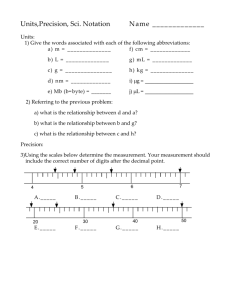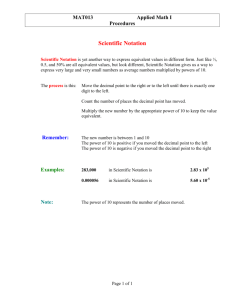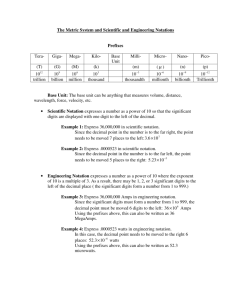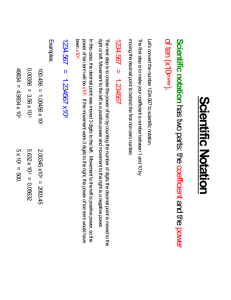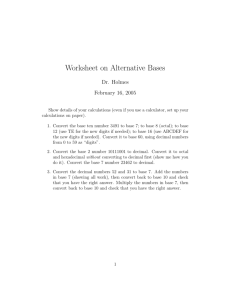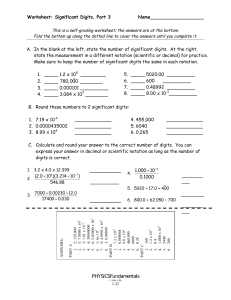Trig Review And Error
advertisement
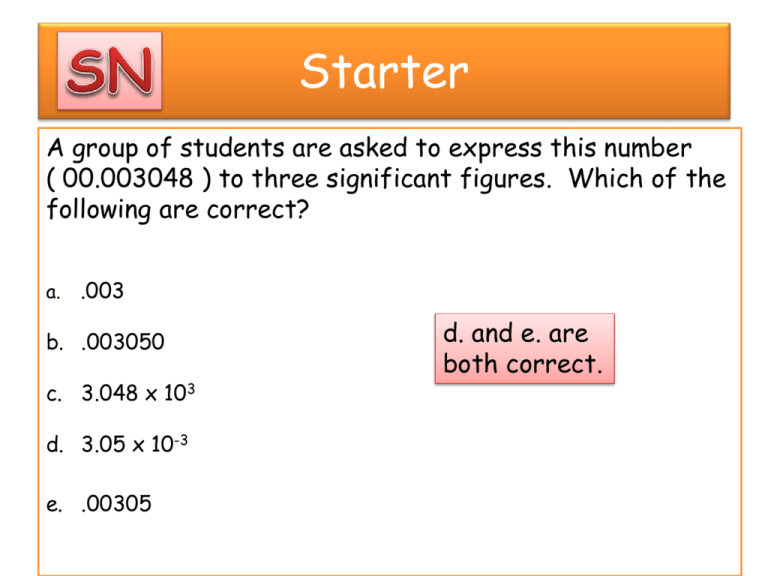
Starter A group of students are asked to express this number ( 00.003048 ) to three significant figures. Which of the following are correct? a. .003 b. .003050 c. 3.048 x 103 d. 3.05 x 10-3 e. .00305 d. and e. are both correct. Conversions Converting From One System of Units to Another You will need a conversion factor like ( 1 meter = 3.28 ft). It can be used two ways: (1m/3.28ft) or ( 3.28ft/1m) Multiply your given dimension by the conversion factor to obtain the desired dimension. How many feet in 2 meters? 2m (3.28ft/m) = 6.56 feet How many meters in 10 feet? 10ft(1m/3.28ft) = 3.05 meters Converting Areas To convert areas, you must square the conversion factor. Conversion factor: 1 inch = 2.54cm A page is 8.5 inches by 11 inches. What is the area in square centimeters? The area in square inches is 95 in2. So…… 95 in2 = __________cm2 95 in2(2.54cm/1 in)2 = 95(6.45 cm2) / (1 in2) = 613 cm2 Converting Volumes To convert volumes, you must cube the conversion factor. A cubic foot is how many cubic inches? Conversion factor: 1 foot = 12 inches 1 ft 3 ( 12 in/ 1 ft)3 = 1 ft 3 ( 123 in3/ 13 ft3) = 1728in3 Using S.I. Prefixes Examples Change 12nm to meters. n = x 10-9 so replace it: 12nm = 12 x 10-9 m Finished. Examples Change 250 grams to kilograms. 1 kg = 1x103 gram 250g ( 1 kg/1x103 g) = .250 kg Scientific Notation If numbers are very large, like the mass of the Earth 5900000000000000000000000 kg Or very small like the mass of an electron : .000000000000000000000000000000911 kg then standard decimal notation is very cumbersome, so we use scientific notation. Scientific Notation A number in scientific notation has two parts: 1st part: a number between 1 and 10 2nd part: 10 to some power. Example: 5.9 x 1024 1024 Means move the decimal 24 places to the right. Example: 6.2 x 10-4 10-4 Means move the decimal 4 places to the left. Examples – Put the number in Scientific Notation a. 345000 Answer: 345000 = 3.45 x 105 b. .00034 Answer: .00034 = 3.4 x 10-4 Multiplication and Division Rule Example xmxn = xm+n xm/xn = xm-n (xm)n = xmn (xy)n = xnyn (x/y)n = xn/yn x-n = 1/xn x2x3 = x2+3 = x5 x6/x2 = x6-2 = x4 (x2)3 = x2×3 = x6 (xy)3 = x3y3 (x/y)2 = x2 / y2 x-3 = 1/x3 Examples Simplify: (2 x 103)(4 x 106) = (2)(4) x 103(106) = 8 x 109 Simplify: (4 x 103)/(2 x 106) = (4)/(2) x 103/106 = 2 x 10-3 Simplify: (2 x 103)3 = 23 x (103 )3 = 8 x 109 Significant Figures How to count the number of significant figures in a decimal number. Zeros Between other non-zero digits are significant. a. 50.3 has three significant figures b. 3.0025 has five significant figures Significant Figures Zeros in front of nonzero digits are not significant: 0.892 has three significant figures 0.0008 has one significant figure Significant Figures Zeros that are at the end of a decimal number are significant. 57.00 has four significant figures 2.000000 has seven significant figures At the end of a non-decimal number they are not. 5700 has two significant figures 2020 has three significant figures Non-Decimal Numbers Major pain to try to figure out the significant figures – it depends on the number’s history. Don’t Use Them. Practice Find the number of significant figures. 1. 2.00450 2. .0034050 3. 4. 1450 0.02040 1. 6 sf’s. 2. 5 sf’s 3. 3 sf’s 4. 4 sf’s Significant Figures After Division and Multiplication After performing the calculation, note the factor that has the least number of sig figs. Round the product or quotient to this number of digits. 3.22 X 2.1 = 6.762 6.8 36.5/3.414 = 10.691 10.7 Significant Figures • Addition or subtraction with significant figures: – The final answer should have the same number of digits to the right of the decimal as the measurement with the smallest number of digits to the right of the decimal. Ex: 97.3 + 5.85 = 103.15 103.2 Trig Review 20 Sine, Cosine, and Tangent H SO q sin q = SO / H SA cos q = SA / H tanq = SO / SA (SO)2 + (SA)2 =H2 21 Example: Find the length of side a and the angles q and f. f 5 3 q q a a2 + 32 = 52 so a2 = 25 – 9 = 16, or a = 4 4/5 = cosq, so q = cos-1(4/5) = 36.9 degrees f + q = 90-, so f = 90 – 36.9 = 53.1 degrees 22 Practice Express each of these in terms of a, b and c. 1. sin(f) = ____________ 2. cos(q) = __________ 3. sin(q) = _____________ 4. tan(f) = ___________ 23 Accuracy vs. Precision Accuracy vs. Precision • Precision is a measure of how close the measurements are to each other. • Poor precision is caused by random errors. Make many measurements to improve precision. • Accuracy is how close the average of the measurements are to the accepted value. • Poor accuracy is caused by uncalibrated measuring devices Measuring Uncertainties Two different experimental results, E1 and E2, are measured by percent difference. An experimental result E is compared to an accepted value A, by percent error. EXIT How could you figure out the how tall the flagpole is that cast this shadow?

